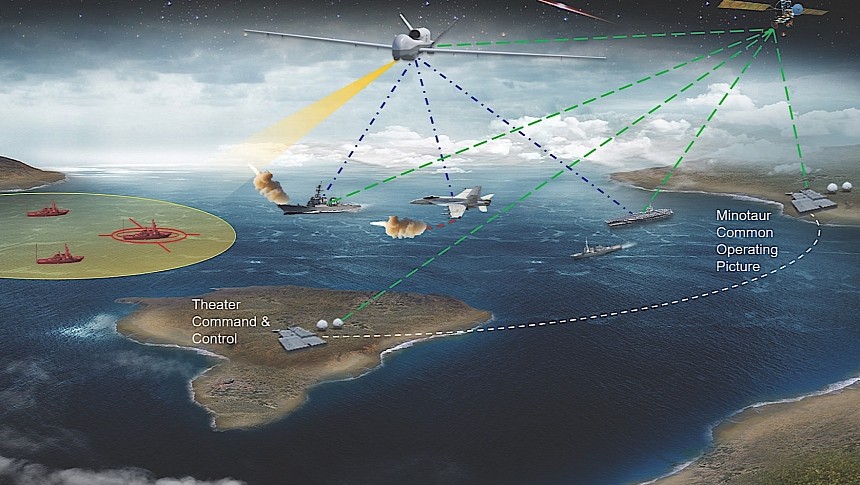It's not long now until the American military gets its hands on a brand new intelligence, surveillance, reconnaissance and targeting (ISR&T) drone. Called MQ-4C Triton, the platform is scheduled to receive its initial operational capability by the end of the year, and it'll bring with it some impressive capabilities, some of which were put to the test during a massive military exercise.
The Triton has been around for a decade now, but its maker, Northrop Grumman, continues to fine-tune the tech to meet the demands of the U.S. military. During Exercise Northern Edge 2023 held in Alaska, the focus fell on something called persistent long-range targeting.
That's a fancy term used to describe the drone's ability to track and keep an eye on targets. In this case, a test bed drone was used to monitor the maritime traffic in the Gulf of Alaska, and send the info back to its ground operators (the Triton is not autonomous, and needs human controllers) for them to determine the best course of action.
"During the exercise, the Triton FTB tracked and monitored all maritime traffic within its broad visual field. Upon receipt of the data, ground operators at Joint Base Elmendorf-Richardson in Anchorage were able to process and disseminate the Gulf of Alaska maritime common operating picture to command and control units using Triton's Minotaur mission interface," the company said in a statement.
As per Northrop Grumman, the Triton was flown repeatedly over the course of a week, managing to perform all of its tasks as expected. Naturally, no actual details of what exactly happened are provided, but one can easily imagine how this flying tool can help American forces keep an eye out for everything and anything happening in an area of interest.
The Triton in its current configuration is a drone capable of staying in the air for 24 hours, looking down at unsuspecting enemies. The highest altitude it can climb to is ten miles (16 km). Powered by a Rolls-Royce turbofan engine, it is capable of moving at speeds of up to 357 mph (575 kph). It can be deployed to work either alone above unfriendly skies, or in cooperation with crewed aircraft flying in the same area.
When it becomes ready for active duty, the drone should enter service primarily with the U.S. Navy, but it will also be used by the Royal Australian Air Force (RAAF), which is a cooperative partner in the Triton program. Some 70 units of the thing are planned to be made over the following years. Each of them has an estimated cost of about $180 million, making the Triton one extremely expensive piece of hardware, but clearly highly valuable in the hands of the military.
That's a fancy term used to describe the drone's ability to track and keep an eye on targets. In this case, a test bed drone was used to monitor the maritime traffic in the Gulf of Alaska, and send the info back to its ground operators (the Triton is not autonomous, and needs human controllers) for them to determine the best course of action.
"During the exercise, the Triton FTB tracked and monitored all maritime traffic within its broad visual field. Upon receipt of the data, ground operators at Joint Base Elmendorf-Richardson in Anchorage were able to process and disseminate the Gulf of Alaska maritime common operating picture to command and control units using Triton's Minotaur mission interface," the company said in a statement.
As per Northrop Grumman, the Triton was flown repeatedly over the course of a week, managing to perform all of its tasks as expected. Naturally, no actual details of what exactly happened are provided, but one can easily imagine how this flying tool can help American forces keep an eye out for everything and anything happening in an area of interest.
The Triton in its current configuration is a drone capable of staying in the air for 24 hours, looking down at unsuspecting enemies. The highest altitude it can climb to is ten miles (16 km). Powered by a Rolls-Royce turbofan engine, it is capable of moving at speeds of up to 357 mph (575 kph). It can be deployed to work either alone above unfriendly skies, or in cooperation with crewed aircraft flying in the same area.
When it becomes ready for active duty, the drone should enter service primarily with the U.S. Navy, but it will also be used by the Royal Australian Air Force (RAAF), which is a cooperative partner in the Triton program. Some 70 units of the thing are planned to be made over the following years. Each of them has an estimated cost of about $180 million, making the Triton one extremely expensive piece of hardware, but clearly highly valuable in the hands of the military.








